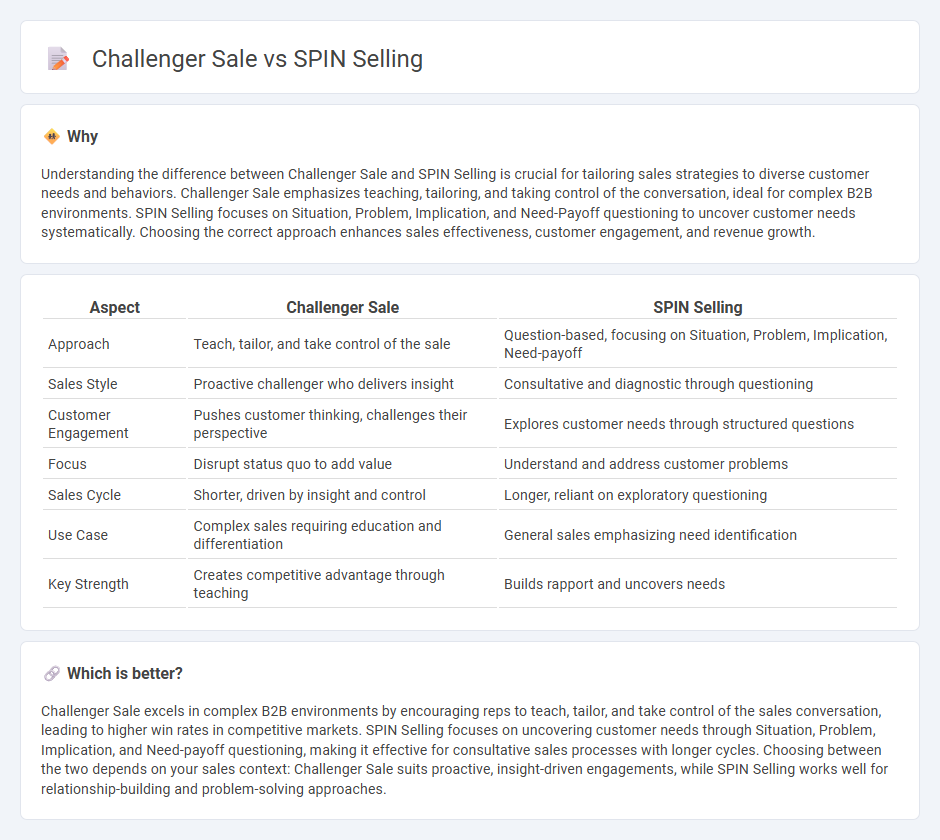
Challenger Sale focuses on teaching sales representatives to challenge customers' thinking and offer unique insights that create value, making them trusted advisors rather than just order takers. SPIN Selling emphasizes understanding customer needs through a structured sequence of Situation, Problem, Implication, and Need-Payoff questions to drive complex sales processes. Discover the key differences and advantages of these methodologies to boost your sales performance.
Why it is important
Understanding the difference between Challenger Sale and SPIN Selling is crucial for tailoring sales strategies to diverse customer needs and behaviors. Challenger Sale emphasizes teaching, tailoring, and taking control of the conversation, ideal for complex B2B environments. SPIN Selling focuses on Situation, Problem, Implication, and Need-Payoff questioning to uncover customer needs systematically. Choosing the correct approach enhances sales effectiveness, customer engagement, and revenue growth.
Comparison Table
| Aspect | Challenger Sale | SPIN Selling |
|---|---|---|
| Approach | Teach, tailor, and take control of the sale | Question-based, focusing on Situation, Problem, Implication, Need-payoff |
| Sales Style | Proactive challenger who delivers insight | Consultative and diagnostic through questioning |
| Customer Engagement | Pushes customer thinking, challenges their perspective | Explores customer needs through structured questions |
| Focus | Disrupt status quo to add value | Understand and address customer problems |
| Sales Cycle | Shorter, driven by insight and control | Longer, reliant on exploratory questioning |
| Use Case | Complex sales requiring education and differentiation | General sales emphasizing need identification |
| Key Strength | Creates competitive advantage through teaching | Builds rapport and uncovers needs |
Which is better?
Challenger Sale excels in complex B2B environments by encouraging reps to teach, tailor, and take control of the sales conversation, leading to higher win rates in competitive markets. SPIN Selling focuses on uncovering customer needs through Situation, Problem, Implication, and Need-payoff questioning, making it effective for consultative sales processes with longer cycles. Choosing between the two depends on your sales context: Challenger Sale suits proactive, insight-driven engagements, while SPIN Selling works well for relationship-building and problem-solving approaches.
Connection
Challenger Sale and SPIN Selling both emphasize understanding customer needs and tailoring sales approaches to complex buying processes. While SPIN Selling focuses on asking Situation, Problem, Implication, and Need-Payoff questions to uncover customer pain points, Challenger Sale integrates this with teaching, tailoring, and taking control to challenge customer thinking. Combining these methodologies enhances sales effectiveness by aligning deep customer insights with assertive, value-driven engagement strategies.
Key Terms
SPIN Selling:
SPIN Selling emphasizes a structured questioning process consisting of Situation, Problem, Implication, and Need-Payoff to uncover customer needs and drive sales effectiveness. This method enables sales professionals to deeply understand client challenges and demonstrate value by addressing specific pain points. Explore more about how SPIN Selling can transform your sales strategy and improve closing rates.
Situation Questions
SPIN Selling emphasizes Situation Questions to gather factual background information critical for understanding the customer's current status and environment. The Challenger Sale, however, focuses less on situational queries and more on teaching and tailoring insights to challenge the customer's thinking. Explore deeper into how these methodologies leverage questioning techniques for maximum sales effectiveness.
Problem Questions
SPIN Selling emphasizes asking Problem Questions to uncover explicit customer needs and challenges, helping sales reps identify pain points for tailored solutions. Challenger Sale focuses on teaching customers by introducing insights that reframe their understanding of problems, prompting reconsideration of current approaches. Explore how these methodologies leverage problem identification differently to boost sales effectiveness.
Source and External Links
What is the SPIN Sales Methodology? - SPIN selling is a research-based consultative sales process created by Neil Rackham in 1988 that guides sales reps to ask four types of questions--Situation, Problem, Implication, and Need-Payoff--to uncover customer needs and build trust during complex B2B sales interactions.
The SPIN Selling Method -- I Took a Deep Dive so You ... - The SPIN method is a strategic questioning sequence designed to help salespeople understand buyer needs deeply and guide prospects through recognizing issues and the benefits of solving them, using Situation, Problem, Implication, and Need-Payoff questions in that order.
The 4 Steps to SPIN Selling - SPIN Selling breaks down into four question types, asked sequentially in sales calls to build toward closing: Situation questions to understand the current state, Problem questions to identify challenges, Implication questions to highlight consequences, and Need-Payoff questions to show solution value, aiding sales reps in navigating complex sales.
 dowidth.com
dowidth.com